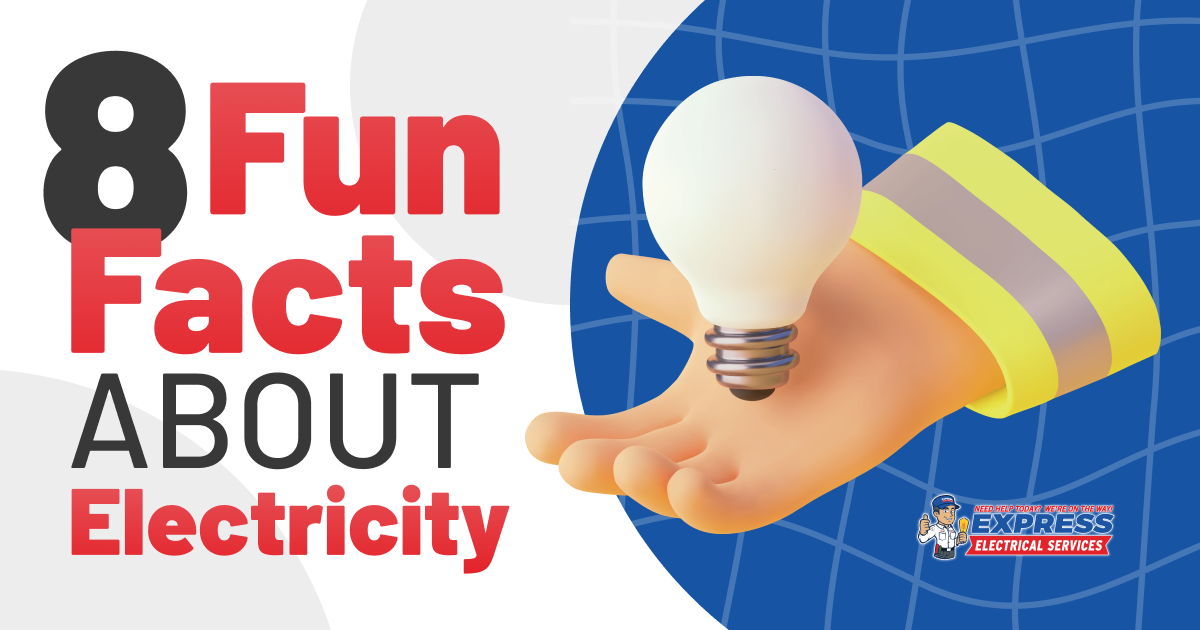8 Fun Facts About Electricity

Electricity powers lights, air conditioners, refrigerators, computers, and even living things. Every device you own requires electrical energy. But there are probably many things about electricity you didn’t know. Hint: It’s not just a convenient power source you depend on daily. We’ll now look at 8 facts about electricity to expand your knowledge.
1. Electricity Travels at Light Speed
Did you know electricity travels at the same speed as the light it produces? That’s 186,000 miles per second or 670,616,629 miles per hour. Electricity is made of electrons, which usually move quite slowly, but are directed very quickly through a wire when you turn on a device.
In 1746, French scientist Jean-Antoine Nollet conducted an experiment with 200 monks. The monks stood in a circle over a distance of more than 1 kilometer, holding an iron wire. When Nollet generated an electrical current, all the monks simultaneously received a shock, demonstrating how fast electricity can move.
2. Humans Experimented with Electricity As Early As Ancient Greece
The Ancient Greeks used electricity as early as 600 BC. They were able to generate static electricity by rubbing fur against amber, a fossilized tree resin. In the 1930s, archeologists discovered posts used by Ancient Romans with hidden copper sheets. It’s believed these were used as batteries to operate lights.
3. Lighting Is Formed by Electricity
Inside clouds, water and ice are forced up by air currents and down by gravity. Their movement and compression build up an electric charge. Typically, a positive charge builds up higher in the clouds and a negative charge builds up at the bottom. The turbulence in a storm separates these charges. The resulting discharge, known as lightning, can contain 300 million volts of electricity (most household devices run at 120 volts). Stepped leaders provide a path for lightning as opposing charges interact; they vary in speed but travel roughly 200,000 miles per hour.
4. Benjamin Franklin Famously Experimented with Electricity
Franklin did not invent electricity. It’s a naturally occurring phenomenon, so it was not invented by anyone. But he conducted numerous experiments, including his infamous kite experiment, to prove how electricity and lightning were connected. He’s credited with inventing the lightning rod to protect buildings against lightning. Benjamin Franklin also combined jars to store charges, thereby coining the term “battery”.
5. Living Things Require Electricity to Survive
You don’t only need electricity to power modern amenities. As mentioned earlier, living things require electricity. One of the interesting things about electrical energy is it’s required to sustain a heartbeat. An EKG machine measures it by detecting electrical pulses. Meanwhile, an electric eel generates up to 600 volts of electricity to ward off predators or stun its prey. A platypus uses electrical impulses for underwater hunting.
At rest, the human body produces about 100 watts of power. An avid sprinter can generate over 2,000 watts!¹ The combined pulses of all your brain’s nerve cells can power a light bulb.
6. Electrocution Only Occurs If You Die
It’s a common myth that any contact with electricity results in electrocution. But think of each part of the word; it combines the terms “electric” and “execute”, therefore referring to death by electricity. If you are shocked by an electric current and don’t die, you haven’t been electrocuted. A current of as little as 50 milliamps can be fatal, while a 1 milliamp current would produce only a faint tingle.
7. Electricity Hums at Different Frequencies, Depending On Where You Are
A hum of an electrical device is caused by an electromagnet that vibrates due to alternating current. In the U.S. and Canada, this is 60 times per second or a frequency of 120 hertz. The sound is between a B and a B-flat. In Europe and most of the world, current alternates at 50 times per second or 100 hertz, producing an A-flat and G-pitched hum.
8. The Electric Car Was Invented in 1832
British inventor Robert Anderson developed a crude electric vehicle (EV) in 1832. A driveable electric car was introduced in the 1870s. William Morrison, a chemist from Iowa, debuted a six-passenger EV in 1890. By 1900, electric cars were commonplace, even as taxis in New York City.
Some of the top names of the time, including Henry Ford and Thomas Edison, experimented with electric cars. But for many decades, the availability of crude oil, lack of electricity across America, and improved road conditions increased the popularity of gasoline engines. That’s until gas supply shortages and environmental concerns reignited the interest in EVs and home charging stations.
Contact Express Electrical Services
We hope these cool facts about electricity help you appreciate its importance, power, and potential danger. Never try to fix an electrical component or device, no matter how simple or minor the issue seems. We provide same-day and emergency electrical services in Southern California. Our licensed technicians can fix a circuit breaker, replace an electrical panel, or rewire your home. To schedule service or learn more about electrical safety, call Express Electrical Services at (323) 727-7799.
Source:

this web is good!!!!!!!!